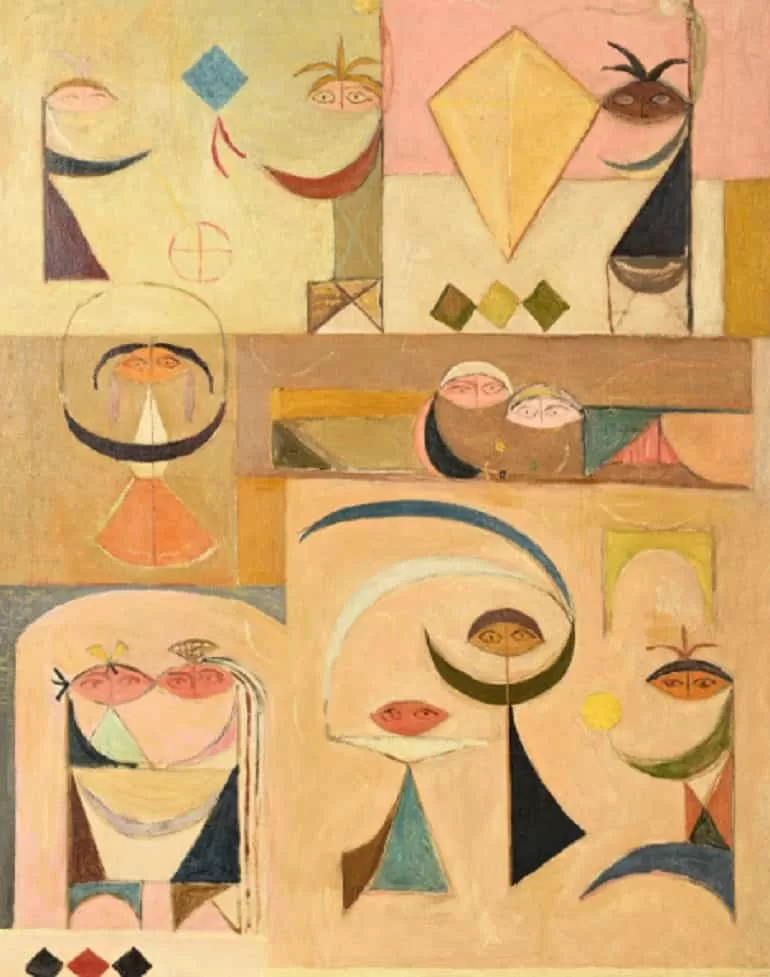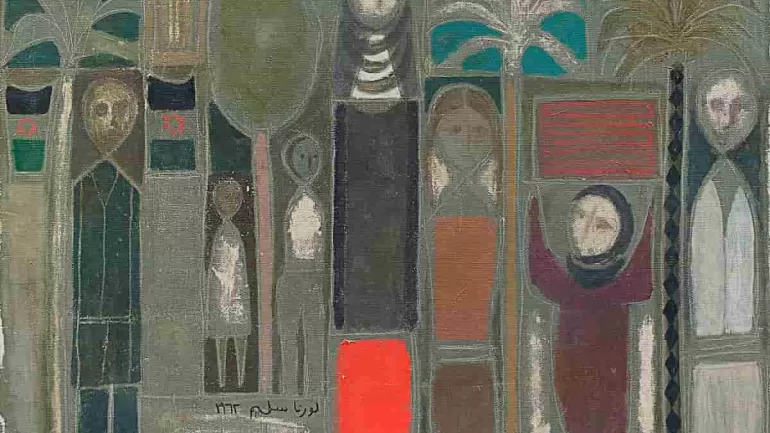ART
The Baghdad Modern Art Group: A Pivotal Force in Postcolonial Art
posted by ARTCENTRONExplore the legacy of the Baghdad Modern Art Group in a powerful exhibition spotlighting Iraqi artists and the future of decolonial curating.
BY KAZEEM ADELEKE, ARTCENTRON
NEW YORK, NY— The exhibition All Manner of Experiments: Legacies of the Baghdad Modern Art Group critically redefines the global discourse on modern art. It highlights the important role of Iraqi artists in shaping a distinctive and radical postcolonial modernism. This groundbreaking exhibition at the Hessel Museum of Art at Bard College provides the first comprehensive scholarly contextualization of the Baghdad Modern Art Group (BMAG). This visionary collective skillfully bridged tradition and innovation during Iraq’s mid-20th century cultural renaissance.
The Genesis of a Modernist Movement
Established in 1951, the Baghdad Modern Art Group emerged in a newly independent Iraq. The nation was undergoing a rapid evolution of its cultural identity following British colonial rule. Artists such as Jewad Selim, Shakir Hassan Al Said, and Mohammed Ghani Hikmat confronted the challenge of reconciling Iraq’s rich visual heritage with contemporary artistic expression. Their work transcended mere imitation of Western trends. Instead, they reconstructed modernism through an Iraqi lens, integrating Mesopotamian symbolism, Islamic abstraction, and vernacular forms into a progressive artistic language. This approach fostered a unique Arab modernism that challenged Eurocentric art historical narratives.
The exhibition spans over seven decades of artistic production, from 1946 to 2023. It features 64 seminal works, encompassing painting, sculpture, and drawing, by over 30 influential Iraqi and Arab artists. The curation meticulously maps the intergenerational dialogues that fueled the group’s creative energy. It showcases complex teacher-student relationships, shared ideologies, and divergent aesthetic visions within the broader context of Middle Eastern modernism.
The BMAG was characterized by its fluid and experimental nature. It eschewed rigid stylistic tenets in favor of material experimentation and conceptual exploration. The organization of All Manner of Experiments reflects this dynamism. Works are presented in experimental narratives, illustrating how artists moved within and beyond the group while united by a shared commitment to artistic and cultural renewal. This flexibility fostered a fertile environment for diverse artistic expressions.
Key Artists and Enduring Artistic Legacies

The Legacy of the Baghdad Modern Art Group
Jewad Selim, widely recognized as a founder of the Baghdad Modern Art Group, advocated for an Iraqi modernism deeply rooted in historical continuity. His profound influence is evident in the works of artists like Naziha Selim, Mohammed Ghani Hikmat, and Shakir Hassan Al Said. Each developed distinctive responses to the group’s mission.
Shakir Hassan Al Said significantly advanced the group’s vision. His theory of “One Dimension” sought to synthesize spiritual mysticism with abstraction. This intellectual framework inspired a younger generation, including Dia al-Azzawi, Suad al-Attar, Ismail Fattah, and Nazar Yahya. These artists extended the BMAG’s legacy into the contemporary artistic landscape, further solidifying its impact on Arab art history.
All Manner of Experiments also spotlights underrepresented and emerging voices. Artists such as Hanaa Malallah, Walid Siti, Sadik Kwaish Alfraji, and Mahmoud Obaidi grapple with the insightful themes of war, exile, and cultural erasure. They continue to advance the aesthetic investigations initiated by the Baghdad Modern Art Group, demonstrating the group’s enduring relevance. Their works often explore themes of displacement, identity, and memory, resonating with contemporary global concerns.
A Pan-Arab and Global Collaborative Effort
This ambitious exhibition is a testament to extensive pan-Arab and global collaboration. It draws on major public and private collections across the Middle East. Key lenders include the Barjeel Art Foundation (Sharjah), the Ramzi and Saeda Dalloul Art Foundation (Beirut), the Farjam Foundation (Dubai), the Ibrahimi Collection (Amman and Baghdad), and Qatar Museums/Mathaf: Arab Museum of Modern Art (Doha). Additionally, contributions from the Dia al-Azzawi Collection and the Hikmat Family Collection enrich the exhibition with rare archival material. Their collection includes artist manifestos, newsreel footage, brochures, and exhibition posters, offering invaluable insights into the period.
The curatorial team was led by Nada Shabout, Tiffany Floyd, and Lauren Cornell. Together, they effectively demonstrate the interconnectedness of modern Iraqi art. It highlights its deep engagement in regional and global artistic exchanges. Baghdad’s vibrant intellectual life during the 1950s–1970s—characterized by its thriving journals, literary salons, and art institutions—positioned the city as a crucial nexus in both Arab and international modernist movements. This period cemented Baghdad’s role as a significant center for cultural production in the Arab world.
Modernism from the South: Rethinking the Canon
One of the exhibition’s most significant contributions is its radical reframing of modernism. Instead of prioritizing Euro-American narratives, All Manner of Experiments asserts Baghdad as a vital cradle of alternative modernisms. The featured artists developed aesthetic forms that articulated the complexities of postcolonial identity, political upheaval, and cultural continuity. Their efforts marked a bold departure from Western paradigms, offering a decolonial perspective on art history.
This innovative approach is particularly evident in the hybridized visual language developed by the Group. Their art flawlessly merged calligraphy, geometry, ancient Iraqi iconography, and avant-garde abstraction. The resulting works evoke both cosmic transcendence and an earthbound political urgency. They bridge ancient mythologies with contemporary realities, showcasing the unique synthesis of traditional and modern elements in Iraqi art.
Loss, Memory, and Cultural Resistance
All Manner of Experiments: Legacies of the Baghdad Modern Art Group functions as more than a mere retrospective; it is a thoughtful act of cultural remembrance. Many of the artworks displayed have been inaccessible to the public for decades. Some pieces survived only through clandestine efforts, smuggled out of Iraq during periods of war and looting. These works are powerful testaments to the resilience of Iraqi artists amidst the devastation of the Iraq-Iran War, the Gulf War, and the 2003 U.S. invasion.
The destruction of Iraqi museums and archives during these conflicts resulted in an irreparable loss of invaluable cultural heritage. All Manner of Experiments functions as a living archive. It preserves the aesthetic contributions of artists who steadfastly refused to be silenced. Their works stand as monuments of resistance. They speak across generations about the ongoing struggle to reclaim identity, history, and dignity in the face of adversity. Their devotion emphasizes the critical role of cultural preservation in post-conflict societies.
Educational Impact and Scholarly Legacy
Accompanying the exhibition is a richly illustrated catalog designed by Hala Al-Ani. It features critical essays from the curators, along with contributions from artists and scholars such as Nabil Salih. These texts offer crucial insights into the political, philosophical, and formal concerns that shaped the BMAG’s work. They also provide essential resources for continued academic exploration and research in the field of modern Arab art.
Students from Bard’s Center for Curatorial Studies—Zuhra Amini and Truth Murray-Cole—significantly contributed to the exhibition’s research and editorial development. This integration ensures that this landmark show is also a vital pedagogical tool. It educates future generations of curators, artists, and historians on the complexities and richness of global modernism and decolonial art histories.
A Timely Reclamation of Iraqi Artistic Heritage
In an era of increasing attention to decolonial curating and global art histories, All Manner of Experiments arrives as a crucial intervention. It powerfully reminds us that the Baghdad Modern Art Group was central to Arab modernism and a critical component of the broader global modernist project. Their contributions must be acknowledged, rigorously studied, and celebrated.
The exhibition succeeds through its powerful ability to bridge the past and present, intertwining memory with imagination, and juxtaposing rupture with renewal. It is a sincere tribute to the vision of the Baghdad Modern Art Group. The show celebrates its courage and enduring impact on the landscape of modern and contemporary art. All Manner of Experiments: Legacies of the Baghdad Modern Art Group encourages a re-evaluation of established art historical canons and promotes a more inclusive understanding of global artistic developments.
- Featured image: Baghdadiyat, a 1962 oil on canvas painting by Lorna Selim, is one of the works showing the impact of the Baghdad Modern Art Group in the exhibition All Manner of Experiments: Legacies of the Baghdad Modern Art Group. Image: Ibrahimi Collection
Share this:
- Click to share on X (Opens in new window) X
- Click to share on Facebook (Opens in new window) Facebook
- Click to share on Reddit (Opens in new window) Reddit
- Click to share on Pinterest (Opens in new window) Pinterest
- Click to share on Tumblr (Opens in new window) Tumblr
- Click to share on Instagram (Opens in new window) Instagram
- Click to share on LinkedIn (Opens in new window) LinkedIn
- More
